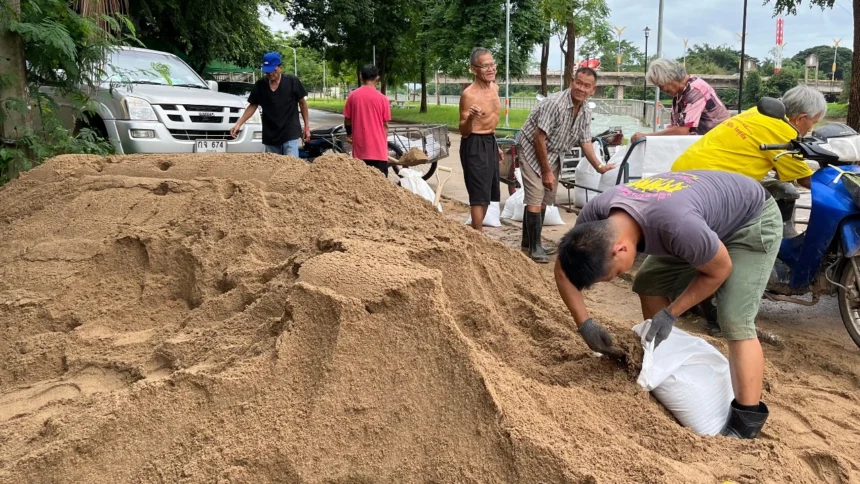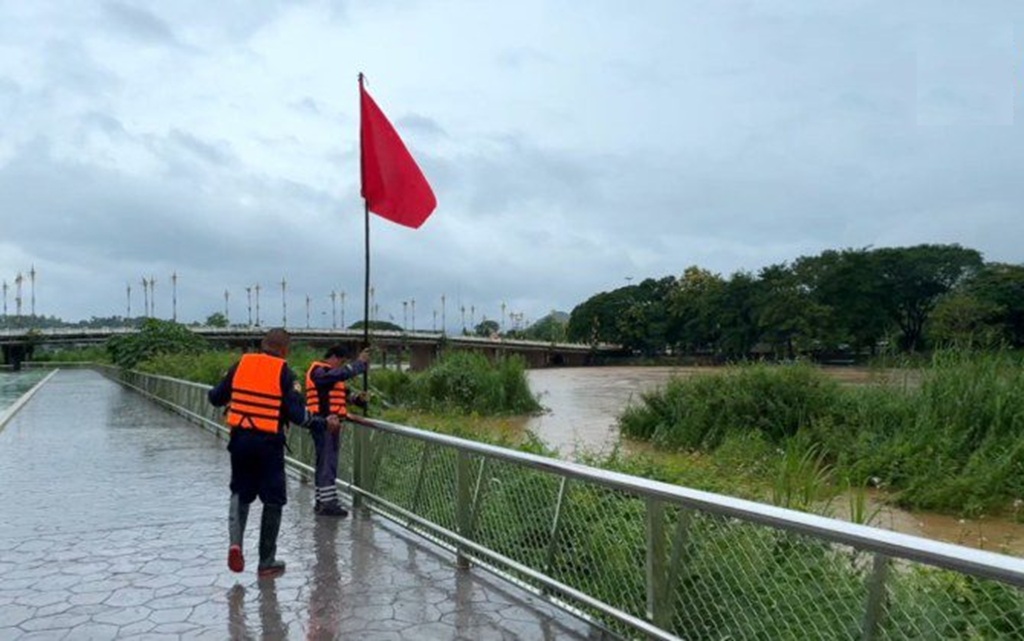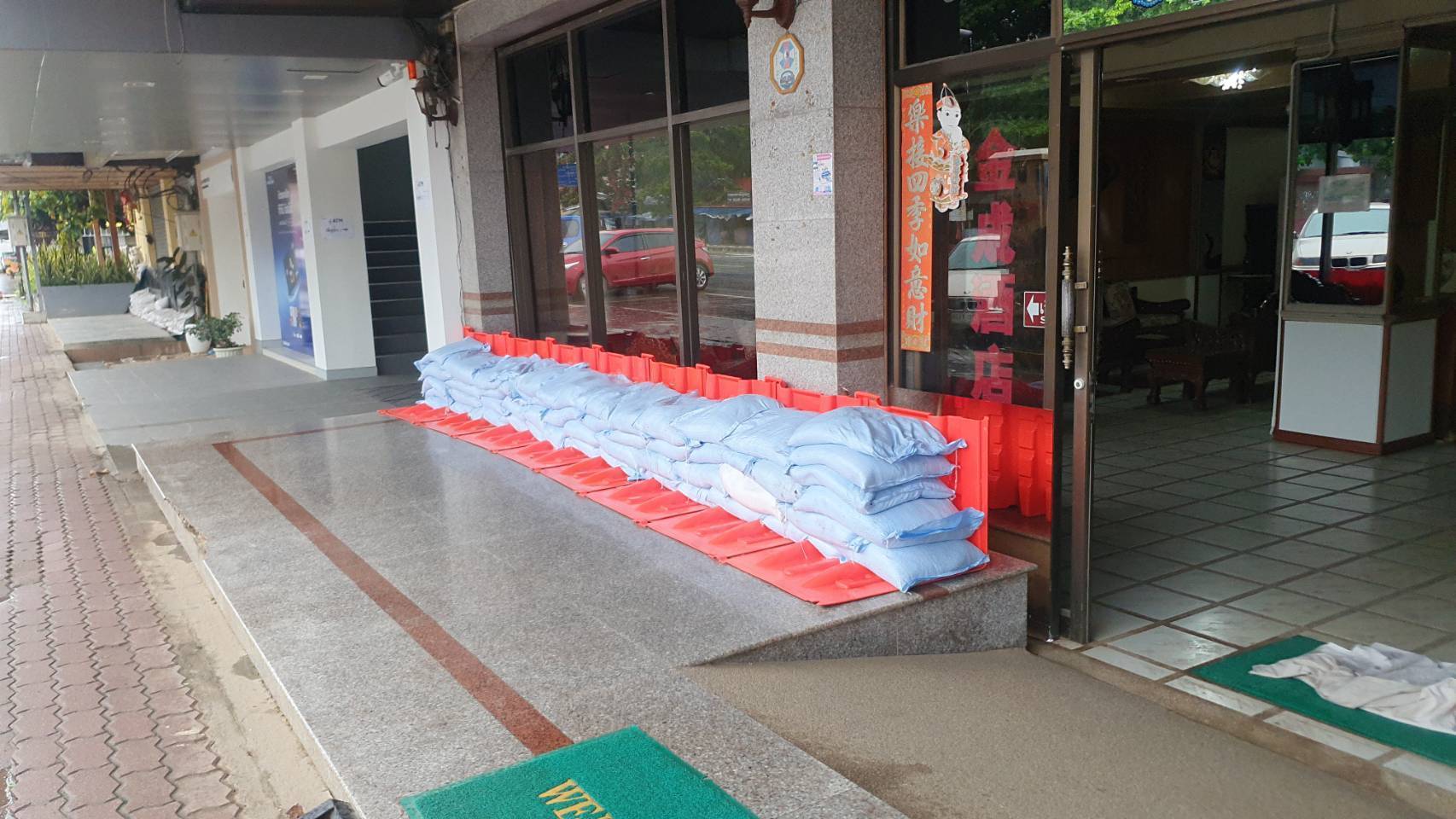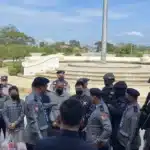CHIANG RAI – As Storm Wipha hits, bringing heavy rain that could cause widespread flooding. Local people and officials are working together to get ready, determined not to repeat last year’s disasters.
Many still remember the worst floods in fifty years that hit the province, and sandbags now line riverbanks and shopfronts from the Kok River to Mae Sai.
The province faced severe flooding last September when Typhoon Yagi combined with seasonal downpours. Both the Kok and Sai Rivers broke their banks. Homes, businesses and fields vanished under water across Mae Sai and Muang.
Some places saw floods nearly waist-deep, with damage estimated at 4 billion baht. The memories still trouble many people who lost so much.
Aree, who runs a stall in Sai Lom Joy Market, remembers it well. She lost her home and business, and is now taking no risks, stacking sandbags in the hope that history won’t repeat itself. “We can’t afford to go through that again. This time, we’re preparing early,” she says.
Mr. David Sittikhankaew, 43 years old, a resident of Pa Daeng community, told the Chiang Rai Times that last year, his house in Pa Daeng community, Tambon Rob Wiang, was flooded up to chest level.
This year, he is afraid that if there is flooding, it will be worse than last year. Therefore, he is preparing by packing sandbags to be ready. If the Kok River overflows, sandbags can be used to alleviate suffering immediately.
There’s a clear sense of urgency in Chiang Rai. Families, local volunteers, and workers are packing sandbags, raising valuables and supporting each other. Many recall the speed with which the water rose last year, with little time to leave.
Sandbags and sand are being given out free by the Chiang Rai Municipality, which has distributed 30 sandbags to each household. If the sand is running low, they can notify the municipality, and they will bring more.
However, for households that need more than 30 sandbags, they can buy them themselves and pack them with the sand that the municipality has piled up.
Warnings Along the Kok River
Local authorities have set up red warning flags along the Kok River, from Chiang Rai Beach through to Rim Kok’s convention centre. These red flags remind everyone of the risks, as last year’s floods forced the closure of the airport and caused chaos downtown.
Disaster teams are monitoring water around the clock as the river edges towards dangerous levels. Deputy Governor Somchai Wattanaporn says, “We’re doing everything we can to keep residents informed.” The warning flags urge people to watch conditions and be ready to move if needed.
Mae Sai, a key border area, is still picking up the pieces from last year. Businesses here aren’t taking chances. At the busy Sai Lom Joy Market, traders shore up barricades and sandbags in case the Sai River overflows again. Shops by the Thai-Myanmar Friendship Bridge are especially wary, since the river has already flooded several times this year.
Acting mayor Wannasilp Jirakas encouraged shop owners to stay ready, saying, “We’ve seen the Sai River breach its banks too many times. While the water levels are not yet at last year’s peak, we’re preparing for the worst.” Army teams have joined efforts, building up embankments and removing blockages in the river to help water flow.
Flood fears are worsened by silt from mining operations in Myanmar, which reduces the river’s capacity and leads to quick flooding, even from moderate rain. Somsak, who runs a local shop, is frustrated: “The mud from across the border clogs the river. Even a little rain causes problems now.”
Demand for Long-Term Flood Defences
With Storm Wipha moving in, many are calling for stronger flood defences and better planning. Last year’s event revealed gaps in drainage and the impact of deforestation upstream. Thanapon Piman from the Stockholm Environment Institute says the answer lies in better cooperation with Myanmar, improved early warning systems, and investment in protective structures such as floodwalls and proper river dredging.
The National Water Resources Office has set aside 74.8 million baht for work on the Sai and Ruak rivers, a project due to finish next month. Locals remember past delays, though. “We’ve been promised solutions before,” Aree points out. “But every year, the water comes back.”
Despite the rain and risk, people in Chiang Rai are working together. Community groups, naval officers and rescue staff are handing out sandbags and helping elderly residents and those in low-lying areas. Groups like the Salvation Army are making sure residents have clean water and food for the days ahead.
As the monsoon continues, Chiang Rai’s community spirit is clear. People hope their hard work and early steps this year will help them avoid losses like those of 2024. For now, sandbags and teamwork are holding the line, while everyone watches the skies, hoping not to see the rivers rise again.
Related Chiang Rai News:
Heavy Rain Alert Issued for Chiang Rai and Northern Thailand
















